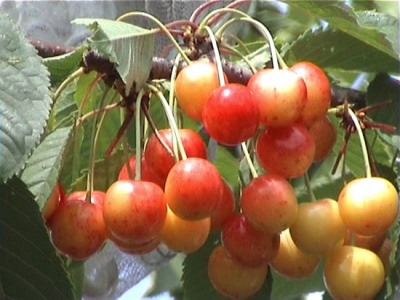
- Fruit shape: rounded
- Authors: Institute of Fruit Growing of the National Academy of Sciences of Belarus
- Appeared when crossing: Narodnaya x Yaroslavna
- Growth type: medium-sized
- Appointment: for all types of processing, for fresh consumption
- Tree height, m: up to 4
- Crown: pyramidal, raised, medium density
- Sheet: small, green
- Fruit size: medium
- Fruit weight, g: 5,7
To enjoy sweet cherries in summer, and delicious and aromatic jam in winter, it is enough to grow a non-capricious and fruitful type of sweet cherry in the garden. These include the medium-early variety of Medunitsa of Belarusian selection.
Breeding history
Medunitsa is a relatively new cherry variety, bred at the Institute of Fruit Growing of the National Academy of Sciences of Belarus. The authors of the variety are a group of scientists - V.S. Zhuk, A.A. Taranov and M.I. Vyshinskaya. The following varieties were used to create sweet cherries: Narodnaya (Belarusian selection) and Yaroslavna (Ukrainian species). In 2004, Medunitsa was transferred for state variety testing. A fruit and stone fruit crop can grow in almost any climatic zone.
Description of the variety
Sweet cherry Medunitsa is a medium-sized tree characterized by a pyramidal, slightly raised crown with medium foliage, shiny, dark green leaves, smooth, brown bark of the trunk and main branches, as well as a strong root system. On average, the height of the tree reaches 3.5-4 meters.
The flowering period for cherries begins in the first ten days of May. At this time, the neat crown of the tree is covered with small snow-white flowers, collected in 2-3 umbellate inflorescences.
Fruit characteristics
Belarusian sweet cherry is a class of large-fruited varieties. A healthy tree grows berries weighing 5.7 grams, endowed with a regular round shape with a perfectly smooth surface. The advantage of the berries is their uniform size and shape. Ripe cherries have an unusual color - orange cover spots are expressed on a yellow background, resembling large blurred dots. The peel of the berries is of medium density, on which a waxy coating is noticeable.
Petioles are separated from elongated stalks of medium thickness without tearing off the flesh, therefore, intact berries tolerate transportation well and are stored for some time in a cool place.
The versatility of the variety allows you to use cherries in cooking, process them into jam and compotes, freeze them, and eat them fresh.
Taste qualities
Cherry Medunitsa - the owner of excellent taste. The yellow flesh has a firm, fleshy, tender and very juicy texture. The taste is dominated by sweetness with honey notes, complemented by a pleasant aroma. The pale red juice has a thick and sugary sweet taste. The peel of the perfect is not felt when eating berries. The small bone is easily separated from the pulp.
Ripening and fruiting
This variety is a medium-early ripening variety. The tree gives its first harvest in the 4th year after planting. Cherries ripen actively in mid-July. Due to the fact that the berries ripen together, the fruiting period is short.

Yield
The crop yield potential is very high. With a favorable climate and proper care, on which the yield of the tree depends, you can get a good harvest.On average, a healthy tree produces 35-40 kg of cherries. On an industrial scale, indicators can reach 26 tons per hectare of plantings.
Self-fertility and the need for pollinators
Cherry of Belarusian selection is self-fertile, so you need to take care of planting pollinating trees with similar flowering periods. Productive donors are the following varieties: Iput, Vityaz, Gastinets, Severnaya and Yantarnaya.
Growing and caring
It is better to plant a cherry seedling in early spring, when the air and soil are warmed up, but the growing season has not yet begun. For planting, buy annual seedlings, which are planted in a sunny place in the garden, keeping a distance between plantings of 3-4 meters, which will prevent shading, which is undesirable for Medunitsa cherries.
Agrotechnics of the tree include: regular watering, top dressing (three times per season), loosening and weeding of the soil, crown formation, removal of dry and diseased branches, disease prevention, soil mulching, preparation for winter.




Disease and pest resistance
The lungwort has high immunity, therefore it does not undergo coccomycosis, monilial burn and most other diseases. The tree is also not very attractive to insect pests, but mice can attack, so one cannot do without protection in the form of a fine-grained metal mesh.

Requirements for soil and climatic conditions
This cherry variety is characterized by high frost resistance, withstanding frosts down to -25 ... 30 degrees, but the flowers can crumble during the return frosts in May. The drought resistance of the tree is average, so watering is important.
Cherry feels comfortable in fertile, air-, moisture-permeable soils with deep groundwater. The best will be light to medium loams with a neutral level of acidity and without moisture stagnation.
































































